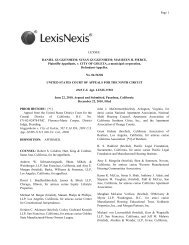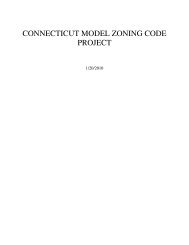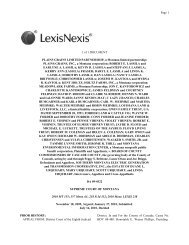Through a Glass Darkly: Measuring Loss Under ... - Land Use Law
Through a Glass Darkly: Measuring Loss Under ... - Land Use Law
Through a Glass Darkly: Measuring Loss Under ... - Land Use Law
Create successful ePaper yourself
Turn your PDF publications into a flip-book with our unique Google optimized e-Paper software.
602 THE URBAN LAWYER VOL. 39, NO. 3 SUMMER 2007<br />
Some contend that the market will have anticipated ex ante the longterm<br />
effects of the regulation, and that this will be reflected in the facial<br />
reduction in price. If the land market could foresee that the regulation will<br />
have a positive effect in the long run, then the valuation after enactment<br />
will be higher than it otherwise would have been. However, while theoretically<br />
true, the ability of the land market to predict accurately by what<br />
sign (positive or negative), and to what extent an individual land use regulation<br />
will have an effect on property value is highly questionable.<br />
V. Legal Analysis<br />
The final section of the article analyzes the proposed valuation methodologies<br />
from a legal perspective; examining the aforementioned methodologies<br />
in order to determine which best fits the text, context, and<br />
legislative history of section 197.352 of the Oregon Revised Statutes.<br />
It is possible to classify in a broad manner the valuation methodologies<br />
encountered in the previous section into three different conceptual<br />
categories 131 :<br />
1. Just compensation is equal to the difference between the current<br />
fair market value, and the fair market value of the affected property<br />
if it is, alone, granted exemption from the land use regulation<br />
(e.g., “Exemption method”).<br />
2. Just compensation is equal to the devaluation in the fair market<br />
value of the property at the time of enactment (or at the time it first<br />
bites on the property’s value) with this devaluation augmented to<br />
reflect the additional revenue which the differential (“taking”)<br />
would have generated up to the date of the written demand (e.g.,<br />
Sercombe’s method).<br />
3. Just compensation is equal to the differential, at the date of<br />
demand, between the fair market value, and the (hypothetical) fair<br />
market value of the property had the regulation never been enacted<br />
or enforced. (e.g., the Plantinga/ Jaeger method or the Hascic and<br />
Wu method).<br />
Despite the difficulties faced in estimating the differential in practice,<br />
it is quite clear that the third conception clearly represents the best interpretation<br />
of section 197.352. The major difficulty of this doctrinally<br />
pure method is plotting the counterfactual scenario as to the value of a<br />
particular property if a regulation now in effect had never been adopted<br />
131. This is a reference to the compensation the method attempts to capture, rather<br />
than the method’s accuracy in application.<br />
ABA-TUL-07-0701-Sullivan.indd 602<br />
9/18/07 10:43:44 AM







